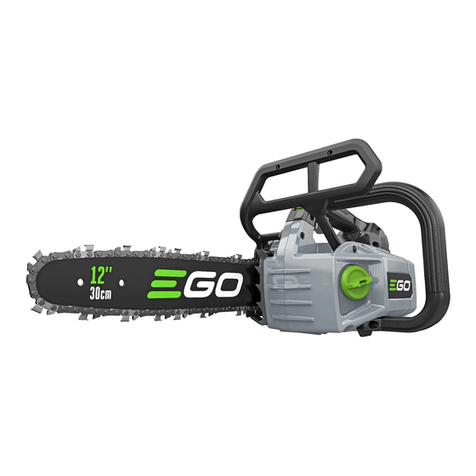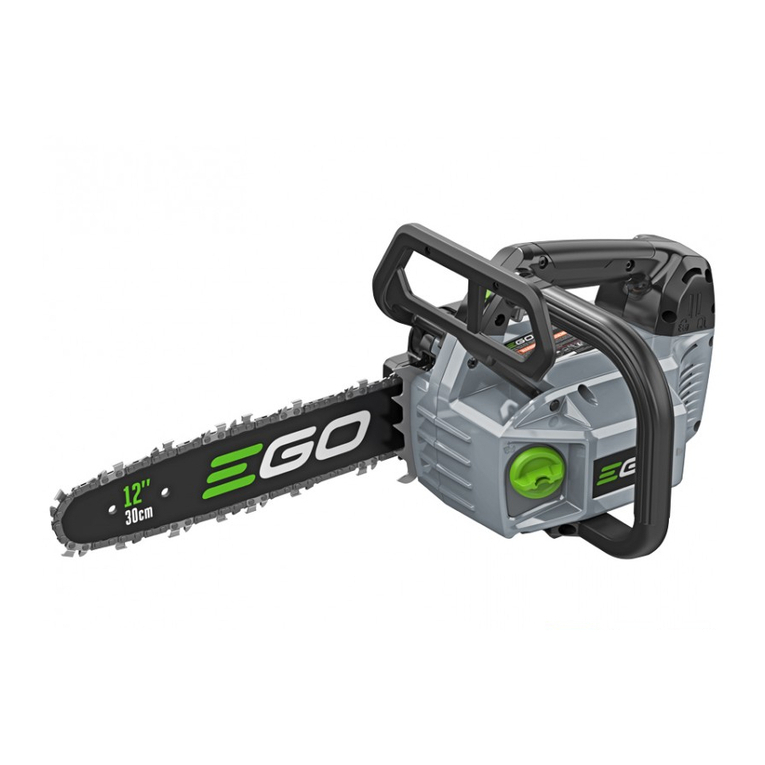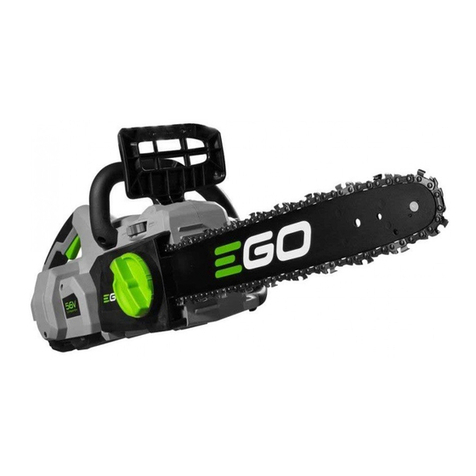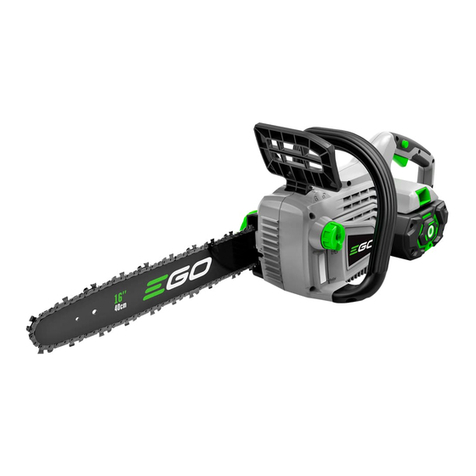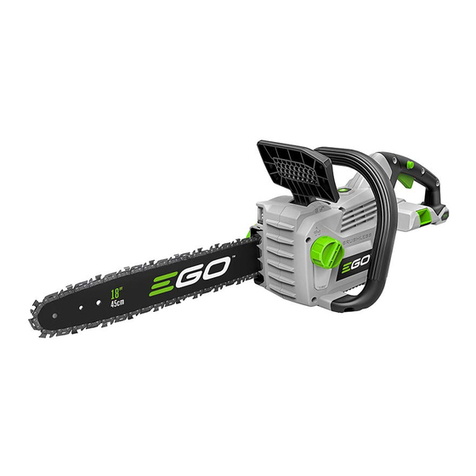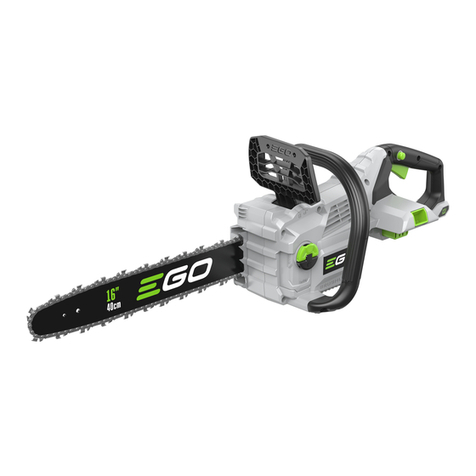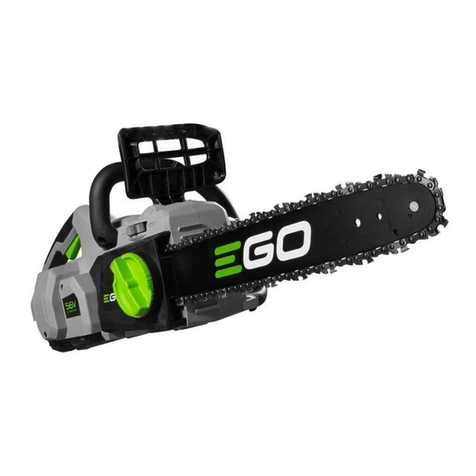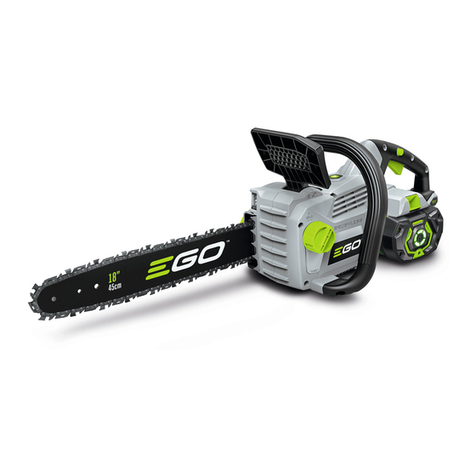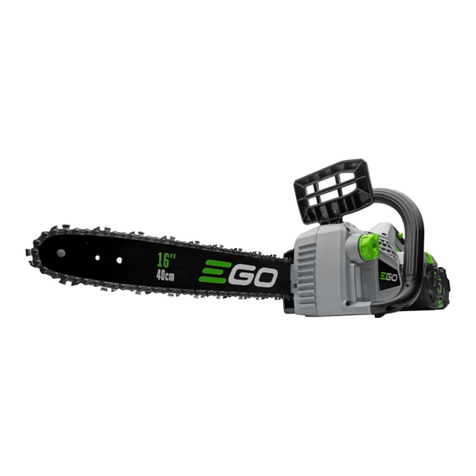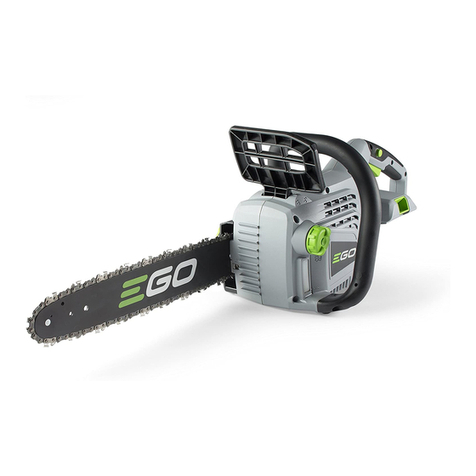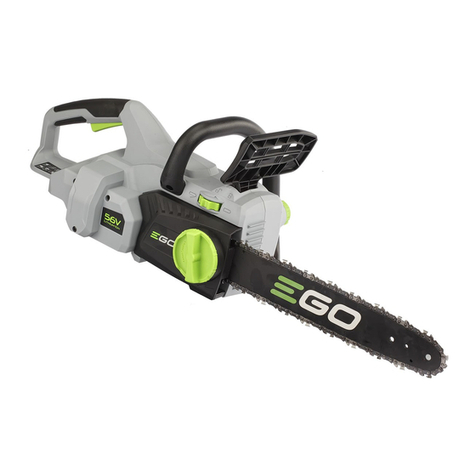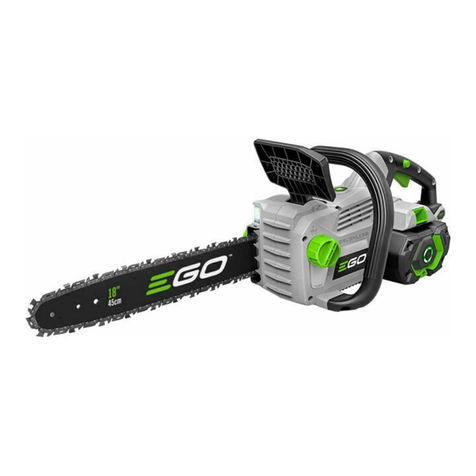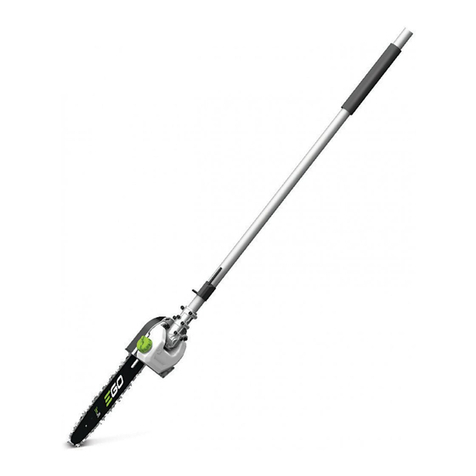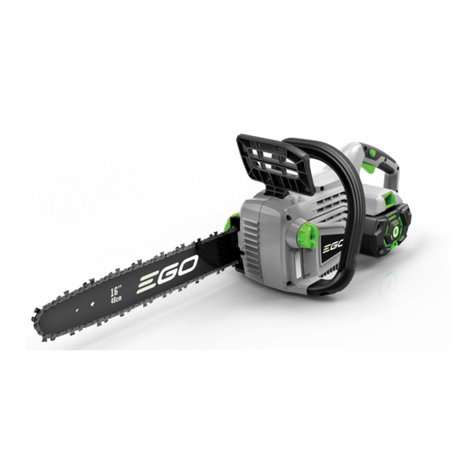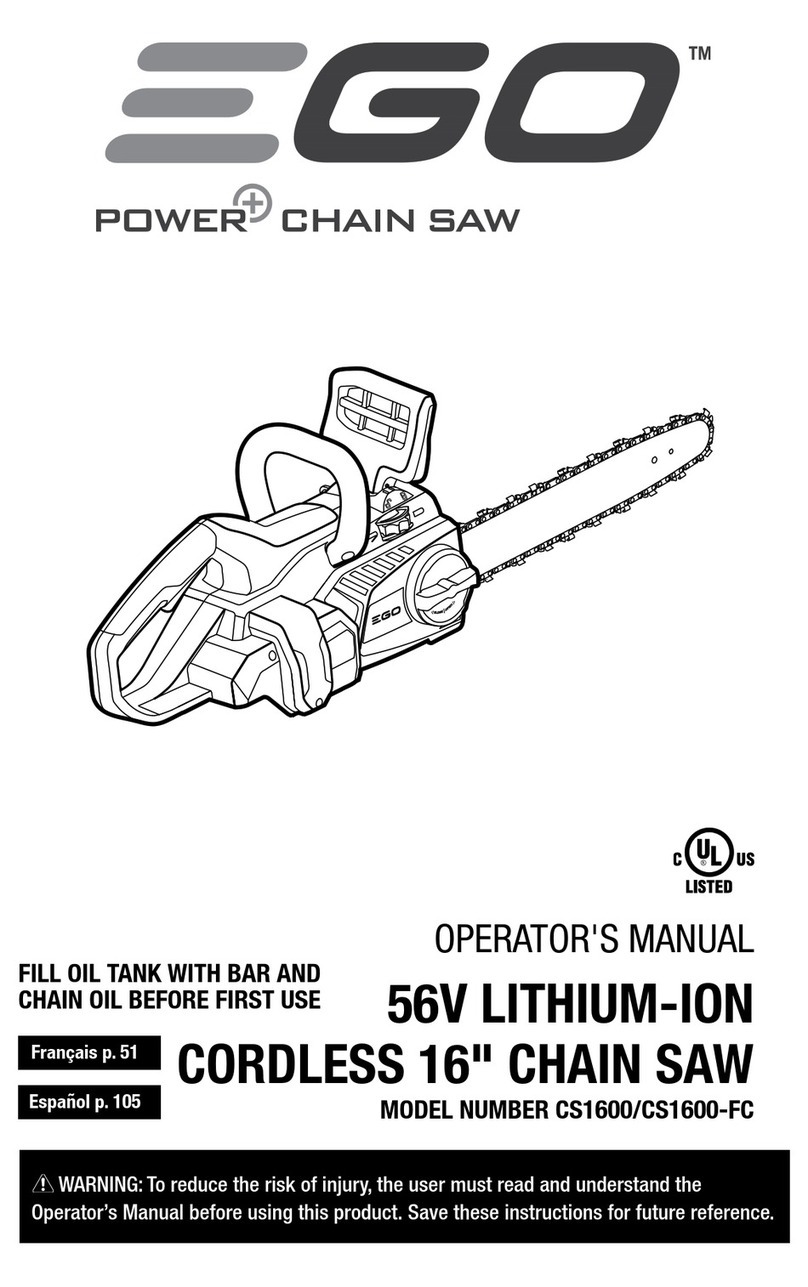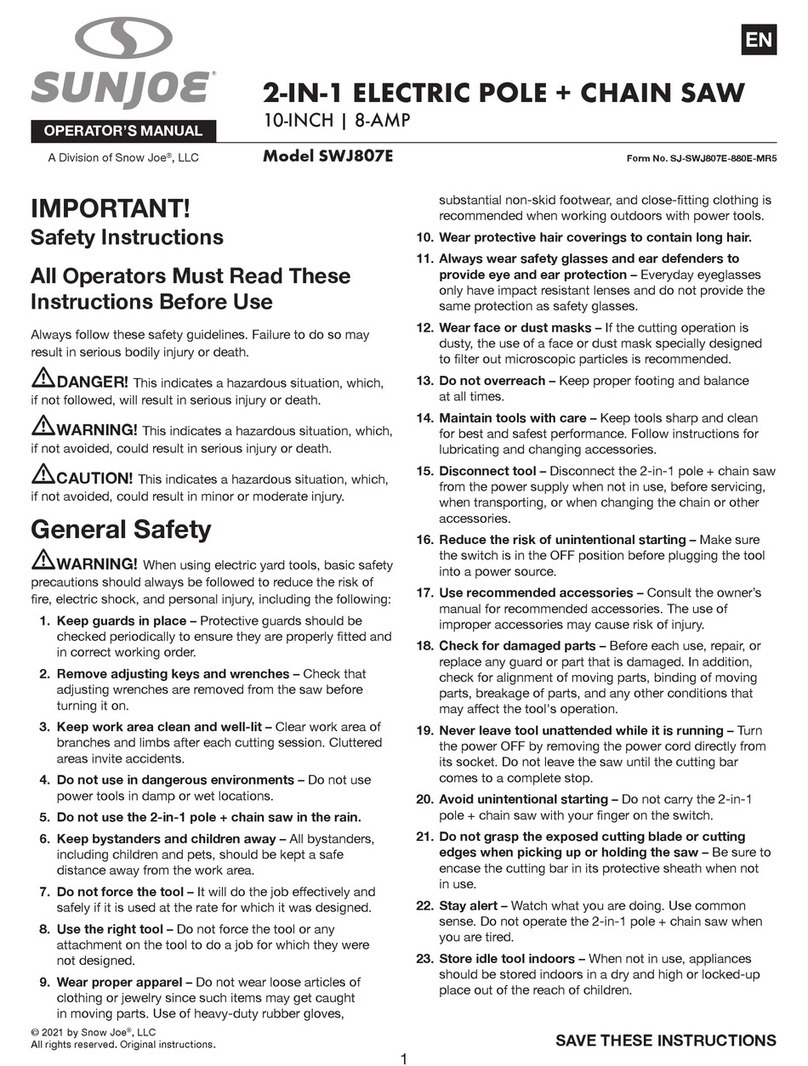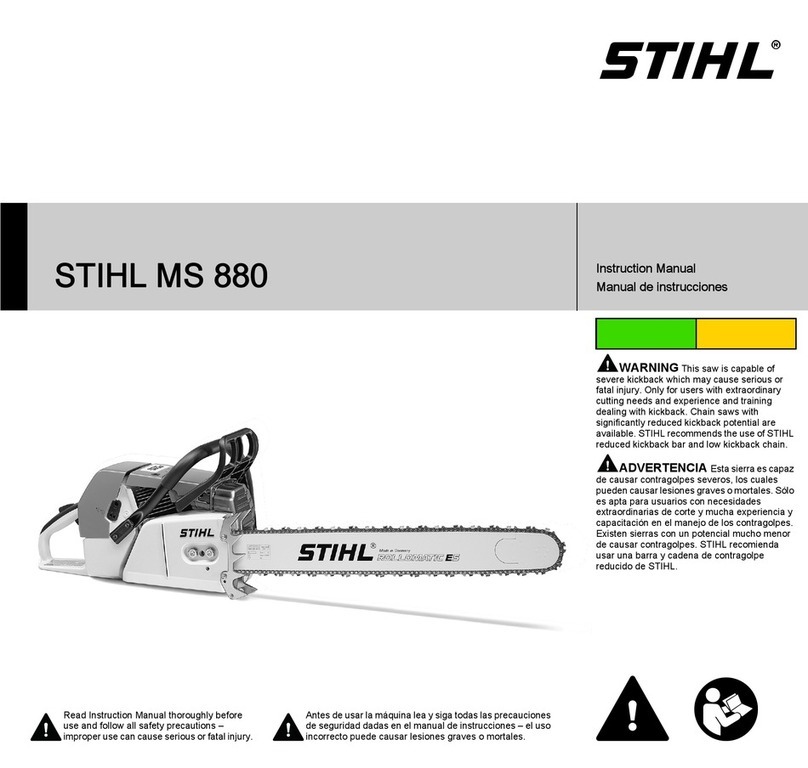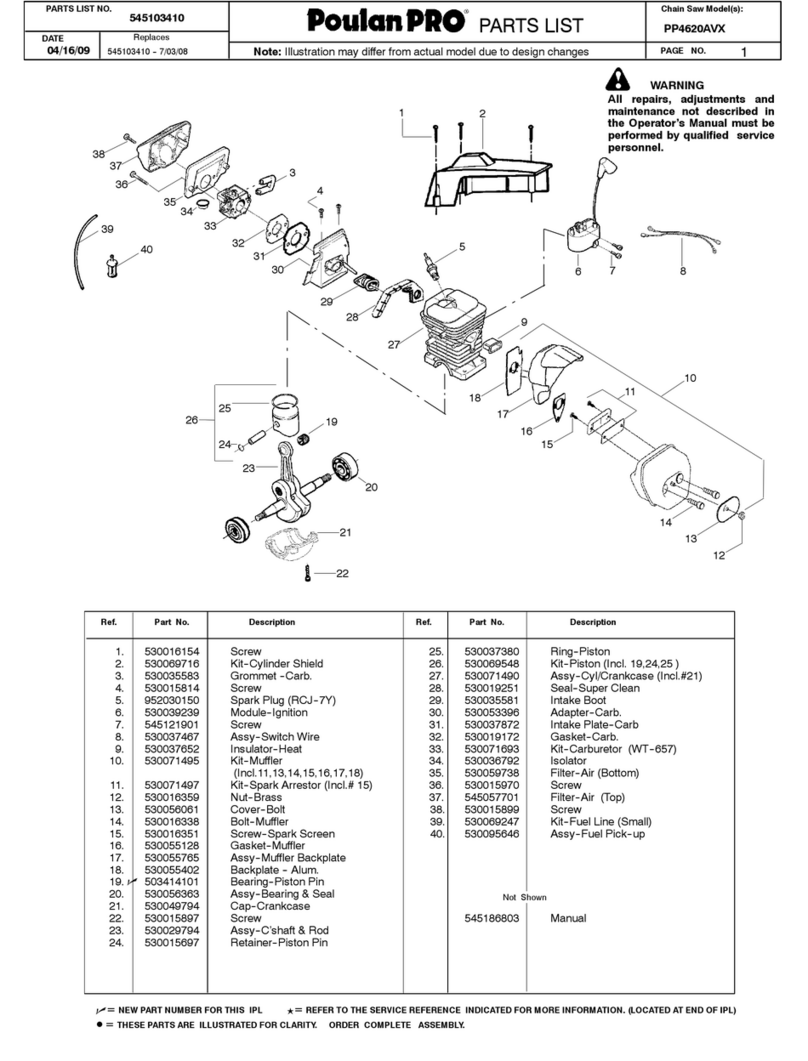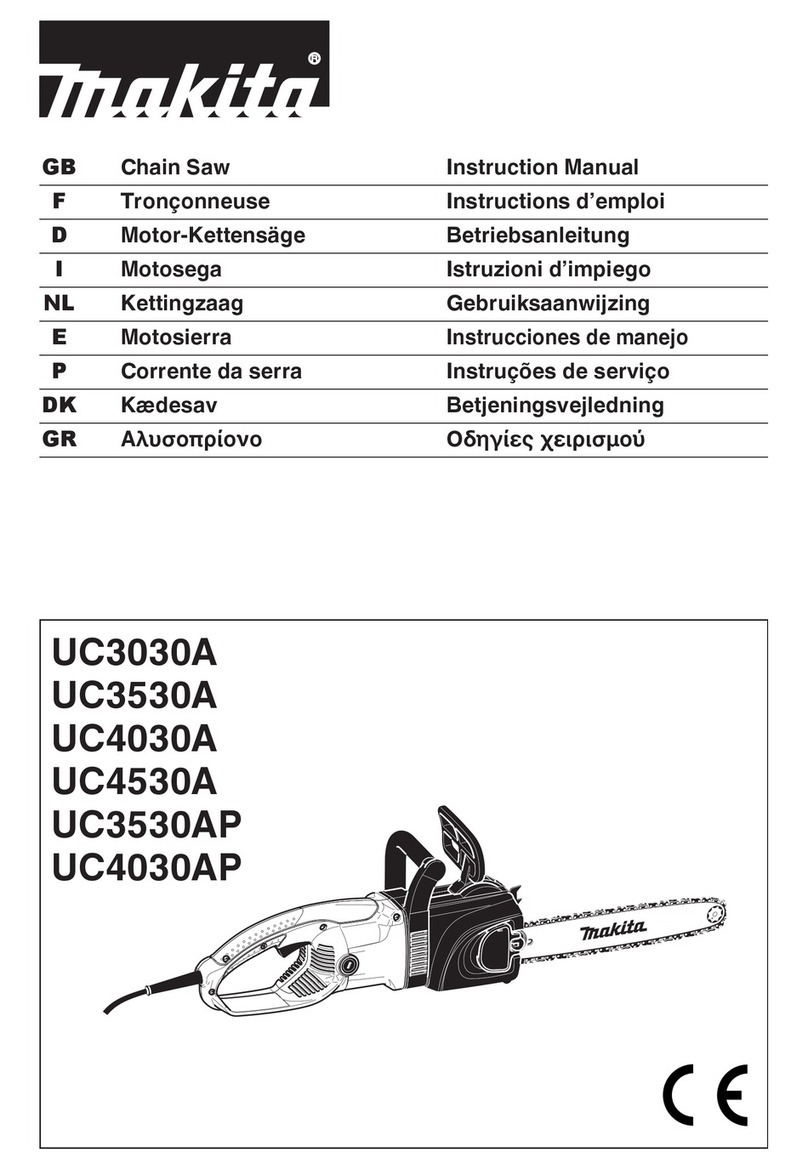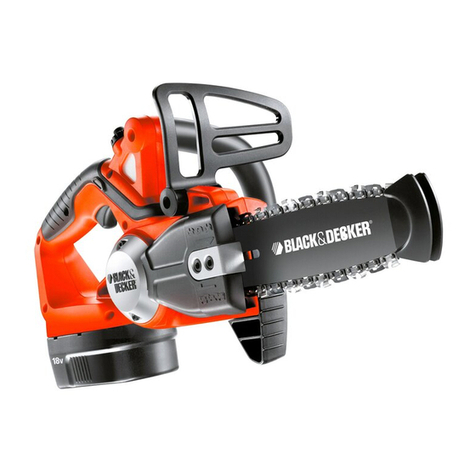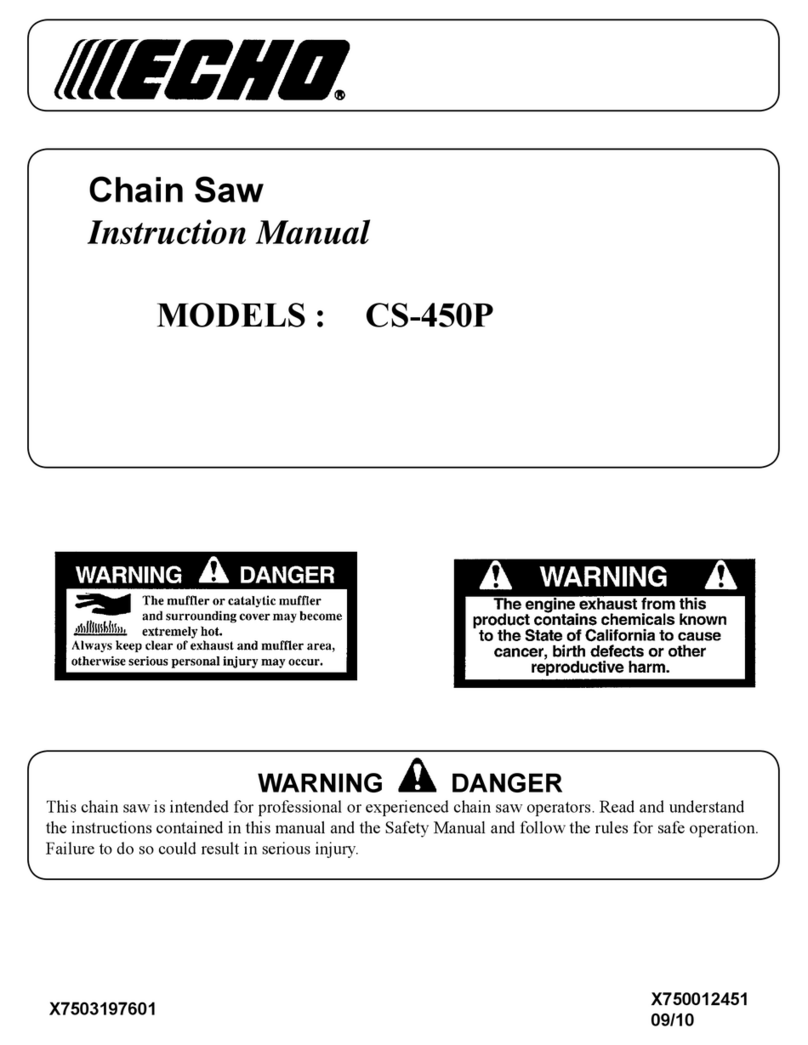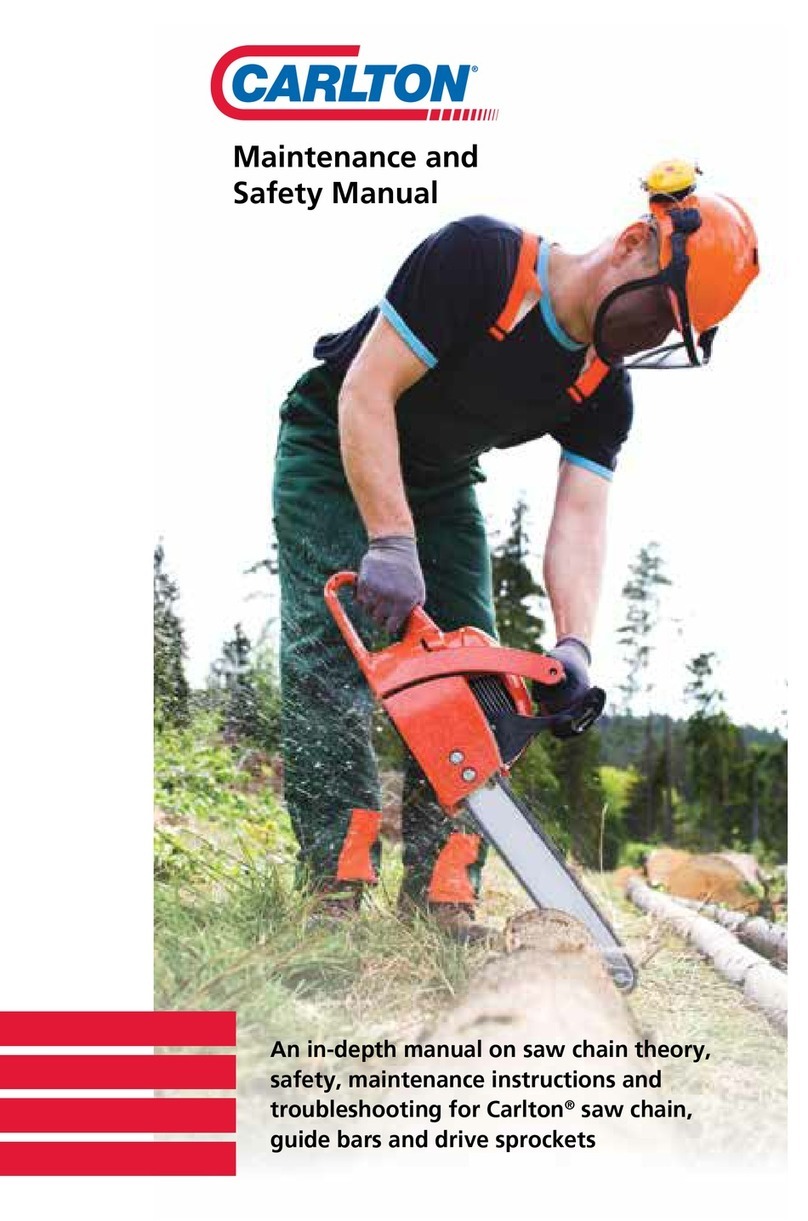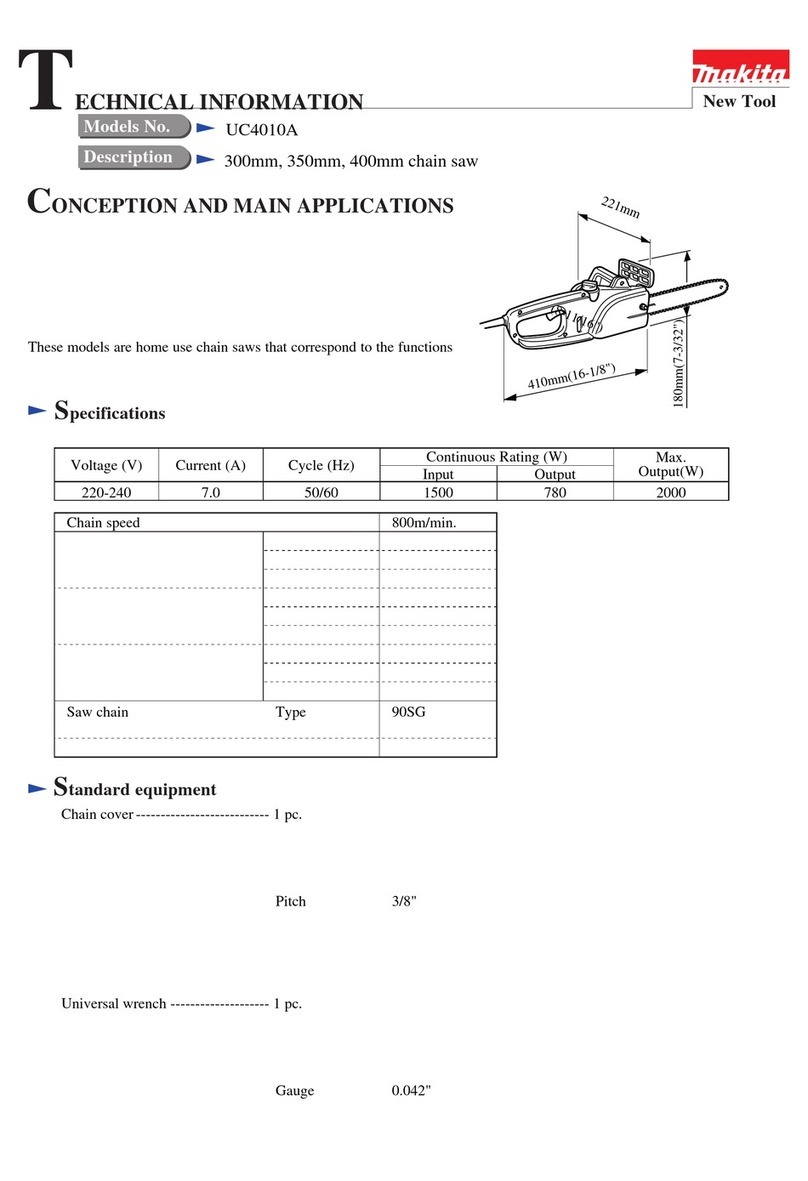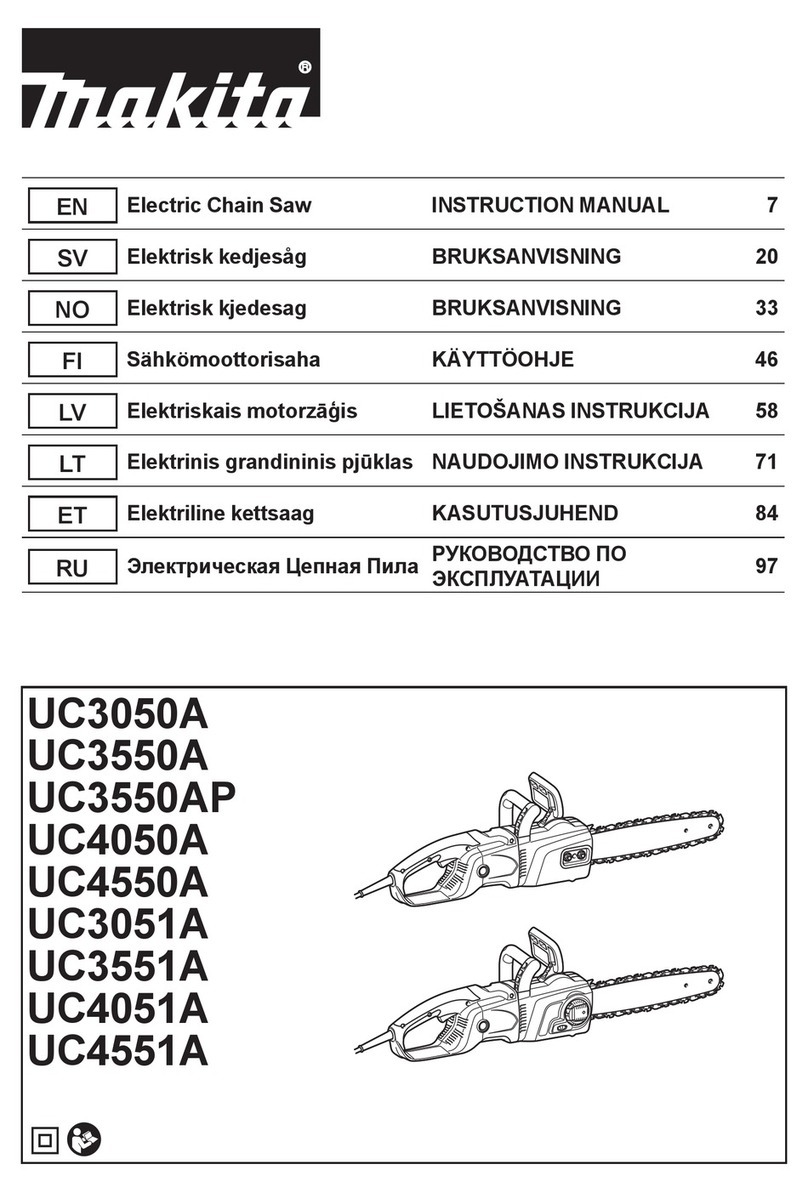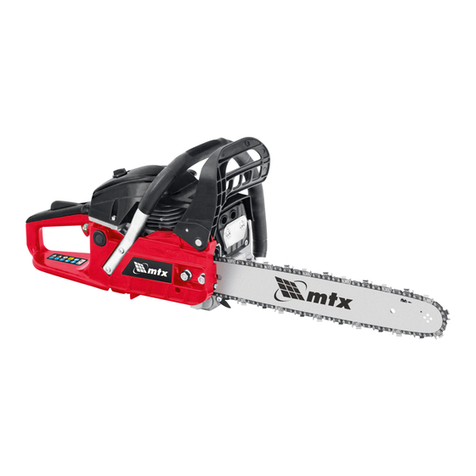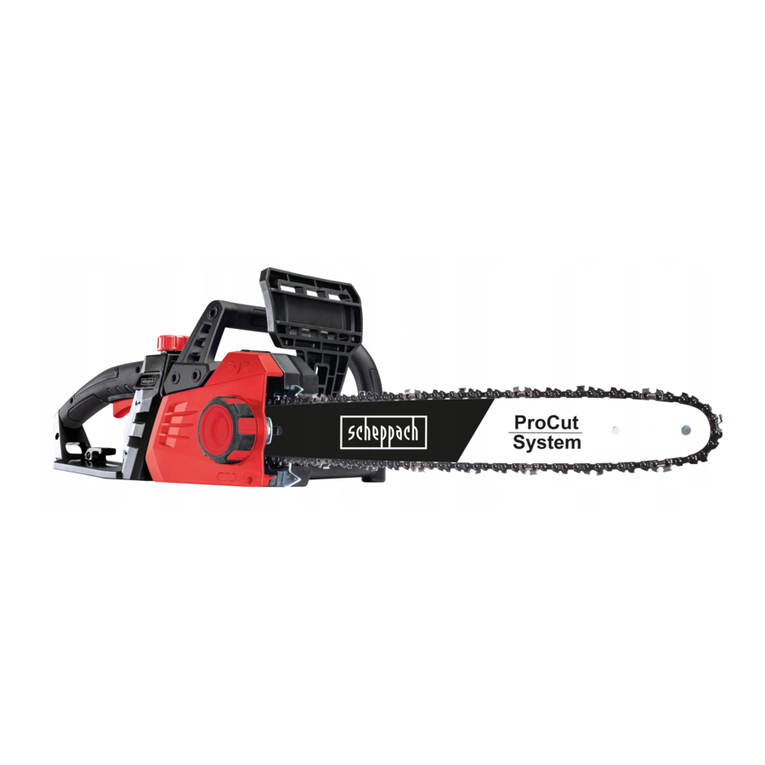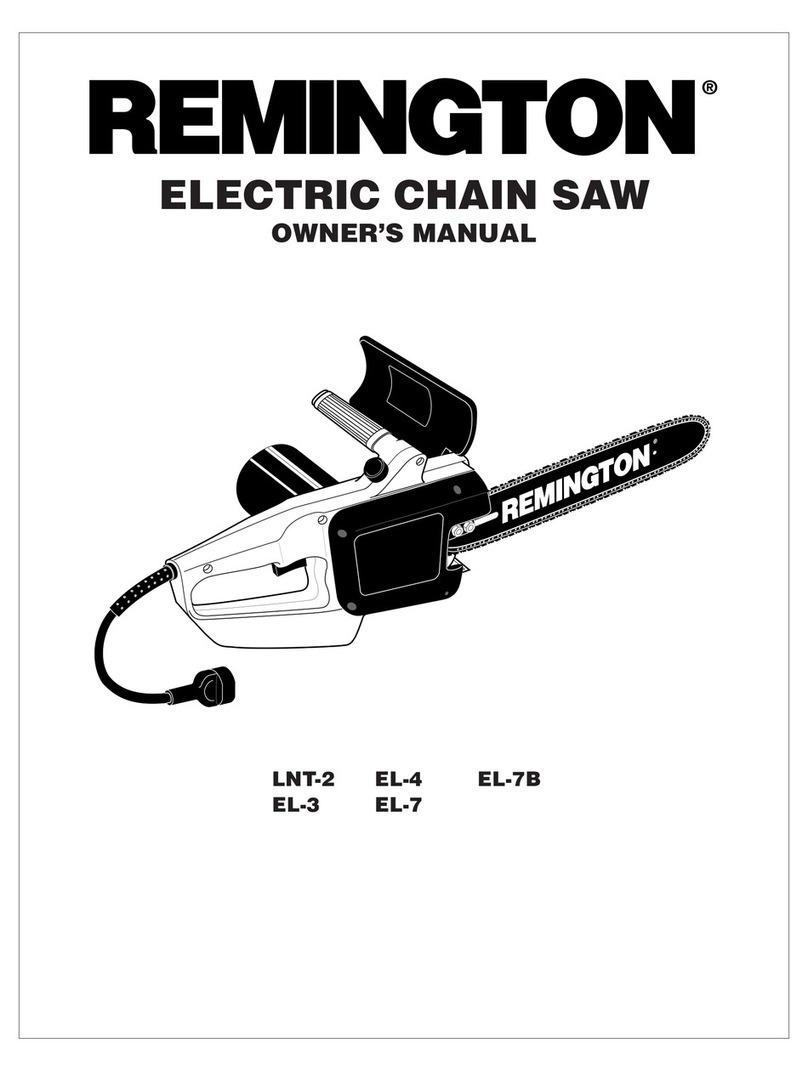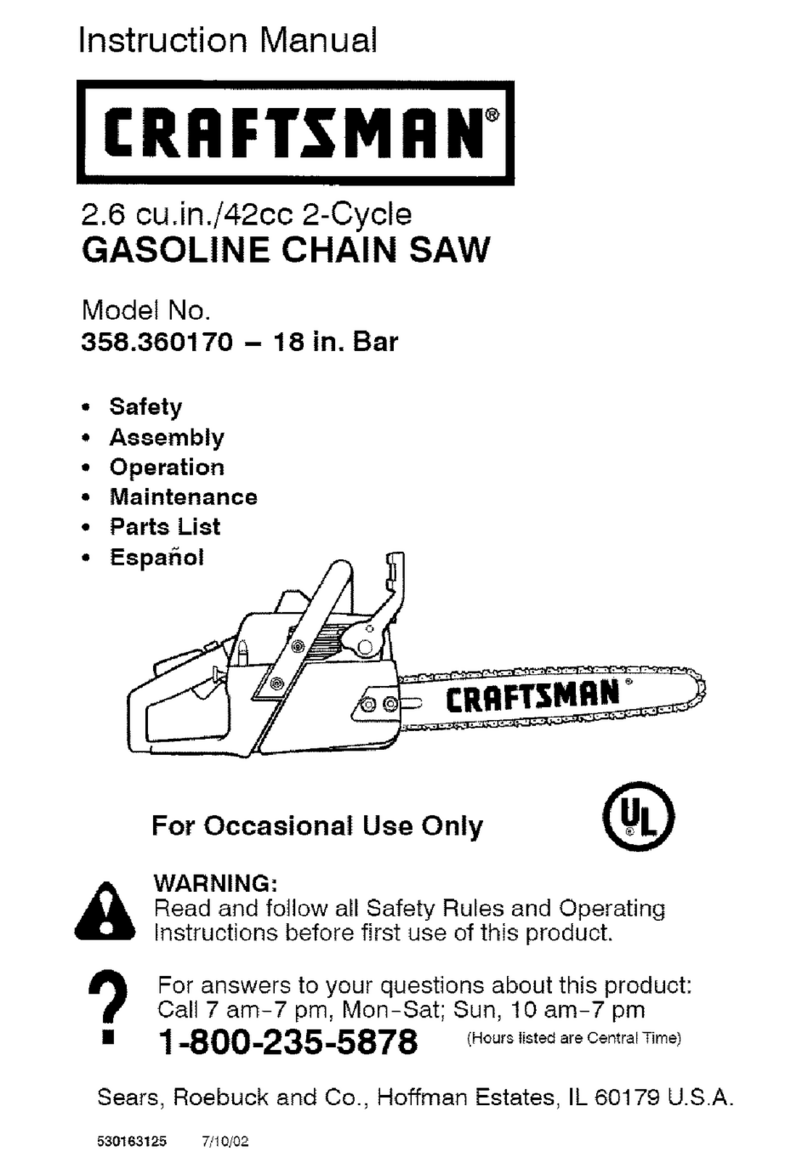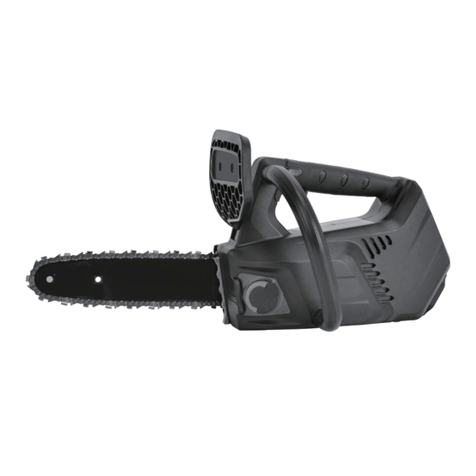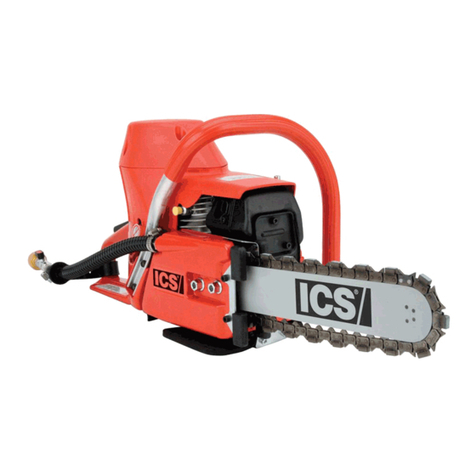EGO CS1400E User manual

OPERATOR'S MANUAL
56 VOLT LITHIUM-ION
CORDLESS CHAIN SAW
MODEL NUMBER CS1400E/CS1600E
EN 56 volt lithium-ion cordless chain saw 6
DE 56 volt lithium-ion kabellose kettensäge 19
FR 56-volt lithium-ionen tronçonneuse sans fil 33
ES Motosierra inalámbrica de ion de litio de 56 v 47
PT Moto-serra sem fios de 56 volts de ião e lítio 62
IT Motosega senza fili a batteria li-lon 56v 76
NL 56v lithium-ion accukettingzaag 90
DK Akku motorsav med 56v litium-ion-batteri 104
SE 56v litium-jon sladdlös kedjesåg 117
FI 56 v:n lulumlonlakulla akkukäyttöinen
moottorisahA 130
NO 56v lithium-ion motorsag uten ledning 143
RU Беспроводная цепная пила на
литий-ионной батарее (56 в) 156
PL Pilarka łańcuchowa bezprzewodowa na
litowo-jonowy akumulator 56v 170
CZ 56v lithium-iontová akumulátorová
řetězová pila 184
SK 56 voltová lítium-iónová bezdrôtová
reťazová píla 197
LT Belaidis grandininis pjūklas su 56 v ličio
jonų akumuliatoriumi 210
LV 56v litija-jonu bezvadu ķēdes motorzāģis 223
ET 56v-liitiumioonakuga akutoitel mootorsaag 236

B
D
C
E
C-1
B-1
7
13
6 5
12
98 10
4 3
1
11 20
19
18
2
14
15
16 17
A

F
H
J
L1
G
K
L2
F-1
F-2
I
12
G-1
G-2
16 17
J-1
L-1L-2L-3L-4
J-2

O
NM
P
Q
S
R
45°
T
1.3 mm
T-1
2
1
T-2 T-2

V
W2
X
Y
U
W1
W3
50 mm
50 mm
U-1
U-2
U-4
1
1
2
2
U-3

56 VOLT LITHIUM-ION CORDLESS CHAIN SAW — CS1400E/CS1600E6
EN
READ ALL INSTRUCTIONS!
READ & UNDERSTAND
INSTRUCTION MANUAL
Residual risk! People with electronic devices, such
as pacemakers, should consult their physician(s) before
using this product. Operation of electrical equipment
in close proximity to a heart pacemaker could cause
interference or failure of the pacemaker.
WARNING: To ensure safety and reliability, all repairs
and replacements should be performed by a qualied
service technician.
SAFETY SYMBOLS
The purpose of safety symbols is to attract your attention to
possible dangers. The safety symbols and the explanations
with them deserve your careful attention and understanding.
The symbol warnings do not, by themselves, eliminate any
danger.The instructions and warnings they give are no
substitutes for proper accident prevention measures.
WARNING: Be sure to read and understand all safety
instructions in this Operator’s Manual, including all safety
alert symbols such as “DANGER,” “WARNING,” and
“CAUTION” before using this tool. Failure to following all
instructions listed below may result in electric shock, re,
and/or serious personal injury.
SYMBOL MEANING
SAFETY ALERT SYMBOL: Indicates DANGER, WARNING,
or CAUTION. May be used in conjunction with other
symbols or pictographs.
WARNING: The operation of any power tools can result
in foreign objects being thrown into your eyes, which can
result in severe eye damage. Before beginning power tool
operation, always wear safety goggles or safety glasses with
side shields and a full face shield when needed. We recom-
mend a Wide Vision Safety Mask for use over eyeglasses or
standard safety glasses with side shields.
SAFETY INSTRUCTIONS
This page depicts and describes safety symbols that may
appear on this product. Read, understand, and follow all
instructions on the machine before attempting to assemble
and operate.
Safety Alert Indicates a potential
personal injury hazard.
Read the
Operator’s
Manual
To reduce the risk of
injury, user must read
operator’s manual.
Wear Eye
Protection
Always wear safety
goggles or safety glasses
with side shields and
a full face shield when
operating this product.
Wear Ear
Protection
Always wear ear protec-
tion when operating this
product.
Wear Head
Protection
Wear an approved safety
hard hat to protect your
head.
Wear
Protective
Gloves
Protect your hands with
gloves when handling
saw and saw chain.
Heavy-duty, nonslip
gloves improve your grip
and protect your hands.
xxxxxxxxxx
xx mm
Guide Bar The information of guide
bar.
Be Aware
of Kickback
Contact of the guide bar
tip with any object should
be avoided
Guide
Bar Tip
Kickback
Tip contact can cause
the guide bar to move
suddenly upward and
backward, which can
cause serious injury.
Two Hand-
ed Hold
Always use two hands
when operating the chain
saw
Do Not
Expose To
Rain
Do not use in the rain or
leave outdoors while it is
raining.
CE This product is in accor-
dance with applicable EC
directives.
XX
Noise
Guaranteed sound power
level. Noise emission
to the environment ac-
cording to the European
community’s Directive.

56 VOLT LITHIUM-ION CORDLESS CHAIN SAW — CS1400E/CS1600E 7
EN
WEEE
Waste electrical products
should not be disposed
of with household waste.
Take to an authorized
recycler.
V Volt Voltage
A Amperes Current
Hz Hertz Frequency
(cycles per second)
WWatt Power
min Minutes Time
Alternating
Current Type of current
Direct
Current Type or a characteristic
of current
n0
No Load
Speed Rotational speed, at no
load
... /min Per Minute Revolutions per minute
GENERAL POWER TOOL SAFETY WARNINGS
WARNING: Read all safety warnings and
instructions. Failure to follow the warnings and instructions
may result in electric shock, re and/or serious injury.
Save all warnings and instructions for future reference.
The term “power tool” in the warnings refers to your
mains-operated (corded) power tool or battery-operated
(cordless) power tool.
WORK AREA SAFETY
◾Keep work area clean and well lit. Cluttered or dark
areas invite accidents.
◾Do not operate power tools in explosive
atmospheres, such as in the presence of
ammable liquids, petrol or dust. Power tools
create sparks which may ignite the dust or fumes.
◾Keep children and bystanders away while operating
a power tool. Distractions can cause you to lose control.
ELECTRICAL SAFETY
◾Power tool plugs must match the outlet. Never
modify the plug in any way. Do not use any
adaptor plugs with earthed (grounded) power
tools. Unmodied plugs and matching outlets will
reduce risk of electric shock
◾Avoid body contact with earthed or grounded
surfaces, such as pipes, radiators, ranges and
refrigerators. There is an increased risk of electric
shock if your body is earthed or grounded.
◾Do not expose power tools to rain or wet
conditions. Water entering a power tool will increase
the risk of electric shock.
◾Do not abuse the cord. Never use the cord for
carrying, pulling or unplugging the power tool.
Keep cord away from heat, oil, sharp edges or
moving parts. Damaged or entangled cords increase
the risk of electric shock.
◾When operating a power tool outdoors, use an
extension cord suitable for outdoor use. Use of a cord
suitable for outdoor use reduces the risk of electric shock.
◾If operating a power tool in a damp location
is unavoidable, use a Ground-fault circuit
interrupter protected supply. Use of GFCI reduces
the risk of electric shock.
PERSONAL SAFETY
◾Stay alert, watch what you are doing and use
common sense when operating a power tool. Do
not use a power tool while you are tired or under
the inuence of drugs, alcohol, or medication. A
moment of inattention while operating power tools may
result in serious personal injury.
◾Use personal protective equipment. Always wear
eye protection. Protective equipment such as dust mask,
non-skid safety shoes, hard hat, or hearing protection used
for appropriate conditions will reduce personal injuries.
◾Prevent unintentional starting. Ensure the
switch is in the off-position before connecting
to power source and/or battery pack, picking up
or carrying the tool. Carrying power tools with your
nger on the switch or energizing power tools that have
the switch on invites accidents.
◾Remove any adjusting key or wrench before turning
the power tool on. A wrench or a key left attached to a
rotating part of the power tool may result in personal injury.
◾Do not overreach. Keep proper footing and
balance at all times. This enables better control of
the power tool in unexpected situations.
◾Dress properly. Do not wear loose clothing or
jewelry. Keep your hair, clothing and gloves away
from moving parts. Loose clothes, jewelry or long
hair can be caught in moving parts.
◾If devices are provided for the connection of dust
extraction and collection facilities, ensure these
are connected and properly used. Use of dust
devices can reduce dust-related hazards.

56 VOLT LITHIUM-ION CORDLESS CHAIN SAW — CS1400E/CS1600E8
EN
POWER TOOL USE AND CARE
◾Do not force the power tool. Use the correct power
tool for your application. The correct power tool will do
the job better and safer at the rate for which it was designed.
◾Do not use the power tool if the switch does not turn
it on and off. Any power tool that cannot be controlled with
the switch is dangerous and must be repaired.
◾Disconnect the plug from the power source and/
or the battery pack from the power tool before
making any adjustments, changing accessories, or
storing power tools. Such preventive safety measures
reduce the risk of starting the power tool accidentally.
◾Store idle power tools out of the reach of children
and do not allow persons unfamiliar with the power
tool or these instructions to operate the power tool.
Power tools are dangerous in the hands of untrained users.
◾Maintain power tools. Check for misalignment or
binding of moving parts, breakage of parts and
any other condition that may affect the power
tool’s operation. If damaged, have the power tool
repaired before use. Many accidents are caused by
poorly maintained power tools.
◾Keep cutting tools sharp and clean. Properly
maintained cutting tools with sharp cutting edges are
less likely to bind and are easier to control.
◾Use the power tool, accessories and tool bits etc.
in accordance with these instructions, taking
into account the working conditions and the
work to be performed. Use of the power tool for
operations different from those intended could result in
a hazardous situation.
BATTERY TOOL USE AND CARE
◾Recharge only with the charger specied by the
manufacturer. A charger that is suitable for one type
of battery pack may create a risk of re when used with
another battery pack.
◾Use power tools only with specically designated
battery packs. Use of any other battery packs may
create a risk of injury and re.
◾When battery pack is not in use, keep it away
from other metal objects, like paper clips, coins,
keys, nails, screws or other small metal objects
that can make a connection from one terminal to
another. Shorting the battery terminals together may
cause burns or a re.
◾Under abusive conditions, liquid may be ejected
from the battery; avoid contact. If contact
accidentally occurs, ush with water. If liquid
contacts eyes, additionally seek medical help. Liquid
ejected from the battery may cause irritation or burns.
SERVICE
◾Have your power tool serviced by a qualied repair
person using only identical replacement parts. This
will ensure that the safety of the power tool is maintained.
CHAIN SAW SAFETY WARNINGS
◾Keep all parts of the body away from the saw
chain when the chain saw is operating. Before
you start the chain saw, make sure the saw chain
is not contacting anything. A moment of inattention
while operating chain saws may cause entanglement of
your clothing or body with the chain.
◾Always hold the chain saw with your right hand
on the rear handle and your left hand on the front
handle. Holding the chain saw with a reversed hand
conguration increases the risk of personal injury and
should never be done.
◾Hold the power tool by insulated gripping
surfaces only, because the saw chain may
contact hidden wiring. Saw chains contacting a
“live” wire may make exposed metal parts of the power
tool “live” and could give the operator an electric shock.
◾Wear safety glasses and hearing protection.
Further protective equipment for head, hands,
legs and feet is recommended. Adequate protective
clothing will reduce personal injury by ying debris or
accidental contact with the saw chain.
◾Do not operate a chain saw in a tree. Operation of a
chain saw while up in a tree may result in personal injury.
◾Always keep proper footing and operate the chain
saw only when standing on xed, secure and
level surface. Slippery or unstable surfaces such as
ladders may cause a loss of balance or control of the
chain saw.
◾When cutting a limb that is under tension be
alert for spring back. When the tension in the wood
bers is released the spring loaded limb may strike the
operator and/or throw the chain saw out of control.
◾Use extreme caution when cutting brush and
saplings. The slender material may catch the saw chain
and be whipped toward you or pull you off balance.
◾Carry the chain saw by the front handle with
the chain saw switched off and away from your
body. When transporting or storing the chain saw
always t the guide bar cover. Proper handling of
the chain saw will reduce the likelihood of accidental
contact with the moving saw chain.
◾Follow instructions for lubricating, chain
tensioning and changing accessories. Improperly
tensioned or lubricated chain may either break or
increase the chance for kickback.

56 VOLT LITHIUM-ION CORDLESS CHAIN SAW — CS1400E/CS1600E 9
EN
◾Keep handles dry, clean, and free from oil and
grease. Greasy, oily handles are slippery causing loss
of control.
◾Cut wood only. Do not use chain saw for purposes
not intended. For example: do not use chain saw
for cutting plastic, masonry or non-wood building
materials. Use of the chain saw for operations different
than intended could result in a hazardous situation.
CAUSES AND OPERATOR PREVENTION OF KICKBACK
(Fig. B, C, D & E)
Kickback may occur when the nose or tip of the
guide bar touches an object, or when the wood
closes in and pinches the saw chain in the cut.
Tip contact in some cases may cause a sudden
reverse reaction, kicking the guide bar up and back
towards the operator (Fig. B).
Pinching the saw chain along the top of the guide
bar may push the guide bar rapidly back towards
the operator (Fig. C).
Fig. B & C operation description see below:
B-1 Rotational kickback
C-1 Linear kickback
Either of these reactions may cause you to lose
control of the saw which could result in serious
personal injury. Do not rely exclusively upon the
safety devices built into your saw.
As a chain saw user, you should take several steps to
keep your cutting jobs free from accident or injury.
Kickback is the result of tool misuse and/or incorrect
operating procedures or conditions and can be avoid-
ed by taking proper precautions as given below:
◾Maintain a rm grip, with thumbs and ngers
encircling the chain saw handles, with both hands
on the saw and position your body and arm to allow
you to resist kickback forces (Fig. E). Kickback forces
can be controlled by the operator, if proper precautions are
taken. Do not let go of the chain saw.
◾Do not overreach and do not cut above shoulder
height. This helps prevent unintended tip contact and
enables better control of the chain saw in unexpected
situations.
◾Only use replacement bars and chains specied
by the manufacturer. Incorrect replacement bars and
chains may cause chain breakage and/or kickback.
◾Follow the manufacturer’s sharpening and
maintenance instructions for the saw chain.
Decreasing the depth gauge height can lead to
increased kickback.
◾Make sure that the area in which you are cutting is
free from obstructions. Do not let the nose of the guide
bar contact a log, branch, fence, or any other obstruction
that could be hit while you are operating the saw.
◾Always cut with the unit running at full speed. Fully
squeeze the switch trigger and maintain cutting speed.
◾With a basic understanding of kickback, you can
reduce or eliminate the element of surprise. Sudden
surprise contributes to accidents.
◾Keep proper footing and balance at all times.
◾Push and Pull – The reaction force is always opposite
to the direction the chain is moving where wood contact
is made. Thus, the operator must be ready to control the
PULL when cutting on the bottom edge of the bar, and
the PUSH when cutting along the top edge (Fig. F).
KICKBACK SAFETY DEVICES ON THIS CHAIN SAW
Chain Brake
The chain saw comes equipped with a chain brake, which
stops both the motor and the motion of the chain when kick-
back occurs. The chain brake can be activated by the forward
motion of the chain kickback brake handle as the saw rotates
backward during kickback; it can also be activated by the
inertial forces generated during rapid pushback.
WARNING: Never modify or attempt to disable the
chain brake.
Make sure that the chain brake is working properly before
using the chain saw. The chain kickback brake handle
should move back and forth easily.
To test the operation of the chain brake, perform the
following steps (Fig. G):
◾Place the chain saw on a at bare surface and make sure
no objects or obstructions that could come in contact
with the bar and chain are in the immediate vicinity.
◾Disengage the chain brake by pulling the chain
kickback brake handle towards the front handle.
◾Start the chain saw.
◾Push the chain kickback brake handle towards the front
of the saw. A properly functioning hand brake will stop the
movement of the chain immediately. If the chain brake is
not working properly, do not use the chain saw until it has
been repaired by a qualied service technician.
Fig. G operation description see below:
G-1 Chain kickback brake handle in operating position
G-2 Chain kickback brake handle in brake position
WARNING: Conrm that the chain brake works
properly before each use.

56 VOLT LITHIUM-ION CORDLESS CHAIN SAW — CS1400E/CS1600E10
EN
WARNING: If the chain brake is clogged with wood
chips, the function of the chain brake may deteriorate.
Always keep the device clean.
Low Kickback Saw Chain
The rakers (depth gauges) ahead of each cutter can
minimize the force of a kickback reaction by preventing the
cutters from digging in too deeply at the kickback zone. Only
use a replacement chain that is equivalent to the original
chain or has been certied one.
CAUTION: As saw chains are sharpened during their
useful life, they lose some of the low kickback qualities
and extra caution should be used.
ADDITIONAL WARNINGS
◾A chain saw is intended for two-handed use.
Serious injury to the operator, helpers, and/or
bystanders can result from one-handed operation.
◾Avoid unintentional contact with the stationary
saw chain or guide bar rails. These can be very
sharp. Always wear gloves and long pants or chaps
when handling the chain saw, saw chain, or guide bar.
◾Never operate a chain saw that is damaged or
improperly adjusted or that is not completely
and securely assembled. Be sure that the saw chain
stops moving when the trigger switch is released.
◾Inspect the work piece for nails, wire, or other
foreign objects prior to cutting.
◾When bucking, secure the work piece prior to
cutting. When felling or pruning, identify and
secure hazardous branches.
◾Aggressive or abusive cutting or misuse of the
chain saw can cause premature bar, chain, and/
or sprocket wear, as well as broken chain or bar,
leading to kickback, chain throw or the ejection
of material.
◾Never use the guide bar as a lever. A bent guide bar
can cause premature bar, chain, and/or sprocket wear,
as well as a broken chain or bar, leading to kickback,
chain throw or the ejection of material.
◾Cut only one work piece at a time.
◾Use only with EGO’s battery packs and chargers.
BATTERY CHARGER
BA1120E, BA2240E, BA2800,
BA3360, BA4200
CH5500E, CH2100E
◾Do not charge the battery pack in rain or in wet
locations.
◾Plan the work, ensuring an obstacle-free work
area and, in the case of felling, at least one
escape path from the falling tree.
◾When felling, keep bystanders at least two tree
lengths away.
◾If situations occur which are not covered in this
manual, use care and good judgment. Contact
EGO Customer Service for assistance.
GUIDE BAR
This saw comes equipped with a guide bar that has a
small radius nose. Small radius noses generally have less
potential for kickback. When replacing the guide bar, be
sure to order the bar listed in this manual.
SAVE THESE INSTRUCTIONS!
SPECIFICATIONS
Model CS1400E CS1600E
Voltage 56 V 56 V
Guide Bar Length 350 mm 400 mm
Chain Pitch 9.5 mm 9.5 mm
Chain Gauge 1.1 mm 1.1 mm
Saw Chain Type 90PX052X
(Oregon)
90PX052X
(Oregon)
90PX056X
(Oregon)
Guide Bar Type 144MLEA041
(Oregon)
144MLEA041
(Oregon)
164MLEA041
(Oregon)
Chain Oil Tank Capacity 150 ml 150 ml
Weight
(without battery pack,
chain sheath)
3.76 Kg 3.86 Kg
Measured sound power
level LWA
96.73 dB(A)
KWA=2.5 dB(A)
96.4 dB(A)
KWA=2.5 dB(A)
Sound pressure level at
operator’s ear LPA
85.73 dB(A)
KPA=2.5 dB(A)
85.4 dB(A)
KPA=2.5 dB(A)
Guaranteed sound power
level LWA
(according to 2000/14/EC)
100 dB(A) 99 dB(A)
Vibration
ah
Rear Handle 5.373 m/s2
K=1.5 m/s2
3.222 m/s2
K=1.5 m/s2
Front Handle 4.146 m/s2
K=1.5 m/s2
3.081 m/s2
K=1.5 m/s2

56 VOLT LITHIUM-ION CORDLESS CHAIN SAW — CS1400E/CS1600E 11
EN
◾The declared vibration total value has been measured
in accordance with a standard test method and may be
used for comparing one tool with another;
◾The declared vibration total value may also be used in a
preliminary assessment of exposure.
NOTICE: The vibration emission during actual use of the
power tool can differ from the declared value in which the
tool is used;In order to protect the operator, user should wear
gloves and ear protectors in the actual conditions of use.
PACKING LIST
PART NAME QUANTITY
Chain saw power head 1
Saw chain 1
Guide bar 1
Chain sheath 1
Operator’s manual 1
DESCRIPTION
KNOW YOUR CHAIN SAW (Fig. A)
1. Trigger Switch
2. Lock-off Button
3. Battery-release Button
4. Oil Tank Cap
5. Oil Inspection Window
6. Saw Chain
7. Guide Bar
8. Latch
9. Ejection Mechanism
10. Electric Contacts
11. Chain Kickback Brake Handle
12. Chain Tensioning Knob
13. Front Handle
14. Rear Handle
15. Chain Tensioning Screw
16. Side Cover
17. Side Cover Knob
18. Chain Sheath
19. Lubricating Hole
20. Sprocket in Guide Bar Tip
NOTICE: The chain kickback brake handle services as the
lever for chain brake activation. It also provides protection
against projecting branches and helps prevent the left hand
from touching the saw chain if it slips off the front handle.
ASSEMBLY
WARNING: If any parts are damaged or missing, do
not operate this product until the parts are replaced. Use of
this product with damaged or missing parts could result in
serious personal injury.
WARNING: Do not attempt to modify this product or
create accessories not recommended for use with this chain
saw. Any such alteration or modication is misuse and could
result in a hazardous condition leading to possible serious
personal injury.
WARNING: To prevent accidental starting that could
cause serious personal injury, always remove the battery
pack from the tool when assembling parts.
ASSEMBLING/REPLACING THE BAR AND CHAIN
WARNING: Always wear gloves when handling the
bar and chain; these components are sharp and may
contain burrs.
1. Position the chain saw power head on its side with
the side cover facing upwards (Fig. H).
2. Turn the side cover knob counterclockwise to remove
the side cover and then loosen the chain tensioning
knob as much as possible.
3. Lay the new saw chain in a loop on a at surface and
straighten any kinks (Fig. I).
4. Place the chain drive links into the guide bar groove
and make the chain a loop at the back of the guide
bar (Fig. J).
5. Hold the chain in position on the guide bar and place
the loop around the sprocket of the power head.
6. Slide the guide bar slot over the alignment anges
until the tension adjusting pin is inserted in the lower
hole in the tail of the bar (Fig. L1).
NOTICE: Small directional arrows are engraved in the
saw chain. Another directional arrow is molded into the
housing. When looping the saw chain onto the sprocket,
make sure that the direction of the arrows on the saw
chain will correspond to the direction of the arrow on the
housing. If they face in opposite directions, turn over the
saw chain and guide bar assembly (Fig. L2).
7. Replace the side cover and slightly tighten the side
cover knob.

56 VOLT LITHIUM-ION CORDLESS CHAIN SAW — CS1400E/CS1600E12
EN
8. Lift the tip of the guide bar up to check for sag
(Fig. K). Release the tip of the guide bar and turn the
chain tensioning knob clockwise. Repeat this process
until the sag is eliminated.
9. Tighten the side cover knob securely to ensure that
the saw chain is properly tensioned before using.
Fig. J & L parts description see below:
J-1 Chain Drive Links L-2 Tension Adjusting Pin
J-2 Guide Bar Groove L-3 Guide Bar Slot
L-1 Alignment Flange L-4 Sprocket
NOTICE: To extend the guide bar life, invert the bar
occasionally.
NOTICE: If chain is too tight, it will not rotate. Loosen
the side cover knob slightly and turn the tensioning knob
once from right to left. Lift the tip of the guide bar up and
retighten the side cover knob securely. Assure that the
chain will rotate without binding.
ADJUSTING THE CHAIN TENSION
◾Stop the motor and remove the battery pack before
adjusting the chain tension. Make sure the side
cover knob is loosened. Turn the chain tensioning
knob clockwise to tension the chain. See the section:
“REPLACE THE BAR AND CHAIN” for additional
information.
◾A cold chain is correctly tensioned when there is no slack on
the underside of the guide bar and the chain is snug, but it
can be turned by hand without binding.The chain must be
re-tensioned whenever the ats on the drive links do not sit
in the bar groove.
◾During normal saw operation, the temperature of
the chain will increase. The drive links of a correctly
tensioned warm chain will hang approximately 1.3 mm
out of the bar groove (Fig. M).
NOTICE: New chains tend to stretch; check chain tension
frequently and tension as required.
NOTICE: A chain tensioned while it is warm may be too
tight upon cooling. Check the cold tension before next use.
OPERATION
WARNING: Do not allow familiarity with this product
to make you careless. Remember that a careless fraction
of a second is sufcient to inict serious injury.
WARNING: Always wear eye protection with side
shields. Failure to do so could result in objects being
thrown into your eyes and other possible serious injuries.
WARNING: Do not use any attachments or
accessories not recommended by the manufacturer of
this product. The use of attachments or accessories not
recommended can result in serious personal injury.
WARNING: To prevent accidental starting that could
cause serious personal injury, always remove the battery
pack from the tool when assembling parts, making
adjustments, cleaning, or when not in use.
Before each use, inspect the entire product for damaged,
missing, or loose parts, such as screws, nuts, bolts, caps, etc.
Securely tighten all fasteners and caps and do not operate
this product until all missing or damaged parts are replaced.
APPLICATION
You may use this product for basic felling, limbing, pruning
and woodcutting of lumber and trees.
NOTICE: The tool is to be used only for its prescribed
purpose. Any other use is deemed to be a case of misuse.
FILLING BAR AND CHAIN LUBRICANT
WARNING: Do not smoke or bring any re or ame
near the oil or the chain saw. Oil may spill and cause a re.
NOTICE: The chain saw is not lled with oil at the time of
purchase. It is essential to ll the tank with oil before use.
The chain is automatically lubricated with chain oil during
operation.
1. Position the chain saw on its side with its oil tank cap
facing towards.
2. Clean the cap as well as the area around and then turn it
counterclockwise to remove (Fig. N).
3. Carefully pour the specically designed oil into the
tank until reaching the bottom of the lter neck.
4. Wipe off any excessive oil and replace the cap.
NOTICE: With upright position, oil should ll the inspection
window. When the oil is no longer visible in the inspection
window, stop use immediately and rell.
ATTACHING/DETACHING THE BATTERY PACK
Fully charge before rst use.
To Attach (Fig. O)
Align the battery ribs with the mounting slots and press
the battery pack down until you hear a “click”.
To Detach (Fig. P)
Depress the battery-release button and pull the battery
pack out.

56 VOLT LITHIUM-ION CORDLESS CHAIN SAW — CS1400E/CS1600E 13
EN
STARTING/STOPPING THE CHAIN SAW
NOTICE: Before starting the chain saw, check for the oil
level, saw teeth sharpness and properly-working kickback
brake handle. Besides, balanced footing and proper
distance away from the ground are needed.
To Start
1. Pull the chain kickback brake handle towards the
front handle to the operating position (Fig. G).
2. Grasp the front and rear handles rmly, using both
hands.
3. Press down the lock-off button rst, then squeeze
the trigger switch to start (Fig. Q). Release the lock-
off button and continue to squeeze the trigger for
continued operation.
WARNING: Do not attempt to start the saw when the
saw chain is in a cut.
To Stop
1. Release the trigger switch.
2. Push the chain kickback brake handle forward to the
brake position to engage the chain brake (Fig. G).
WARNING: Always remove the battery pack from the
chain saw during work breaks and after nishing work.
Proper Grip On Handles (Fig. E)
◾Wear non-slip gloves for maximum grip and
protection.
◾With the saw on a rm, at surface, hold the saw
rmly with both hands.
◾Always grasp the front handle with the left hand and
the rear handle with the right.
◾The ngers should encircle the handle, with the thumb
wrapped under the front handle.
WARNING: Never use a left-handed (cross-handed)
grip, or any stance which would place your body or arm
across the chain line (Fig. R).
Proper Cutting Stance (Fig. S)
◾Both feet should be on solid ground, with weight evenly
spread between them.
◾The left arm should be straight, with the elbow locked.
This helps to withstand the forces generated by kickback.
◾Your body should always be to the left of the chain line.
INSTRUCTIONS CONCERNING THE PROPER
TECHNIQUES FOR BASIC FELLING, LIMBING, AND
CROSS-CUTTING
WARNING: Always be sure of your footing and hold the
chain saw rmly with both hands while the motor is running.
WARNING: When the saw chain is stopped due to
pinching during cutting, release the trigger switch; remove
the saw chain and guide bar from the wood, then restart
the chain saw.
WARNING: Do not pull the saw chain with hand
when it is bound by the sawdust. Serious injury could
result if the chain saw starts accidentally. Press the saw
chain against the wood, move the chain saw back and
forth to discharge the debris. Always remove the battery
pack before cleaning. Wear heavy protective gloves when
handling the saw chain.
WARNING: Never start the chain saw when it is in
contact with the wood. Always allow the chain saw reach
full speed before applying the saw to the wood.
Felling a tree
◾When bucking and felling operations are being
performed by two or more persons at the same time,
the felling operation should be separated from the
bucking operation by a distance of at least twice the
height of the tree being felled. Trees should not be
felled in a manner that would endanger any person,
strike any utility line or cause any property damage.
If the tree does make contact with any utility line, the
utility company should be notied immediately.
◾The chain saw operator should stand on the uphill
side of the terrain, as the tree is likely to roll or slide
downhill after it is felled.
◾An escape path should be planned and cleared as
necessary before cuts are started. The escape path
should extend back and diagonally to the rear of the
expected line of fall as Fig. T shown.
◾Before felling is started, consider the natural lean of
the tree, the location of larger branches and the wind
direction to judge which way the tree will fall.
◾Remove dirt, stones, loose bark, nails, staples and wire
from the tree.

56 VOLT LITHIUM-ION CORDLESS CHAIN SAW — CS1400E/CS1600E14
EN
Notching undercut
Make the notch 1/3 the diameter of the tree, perpendicular
to the direction of falls as Fig. U shown. Make the lower
horizontal notching cut rst. This will help to avoid pinch-
ing either the saw chain or the guide bar when the second
notch is being made.
Felling back cut
◾Make the felling back cut at least 50 mm higher than
the horizontal notching cut as Fig. U shown. Keep the
felling back cut parallel to the horizontal notching cut.
Make the felling back cut so enough wood is left to
act as a hinge. The hinge wood keeps the tree from
twisting and falling in the wrong direction. Do not cut
through the hinge.
◾As the felling gets close to the hinge, the tree should
begin to fall. If there is any chance that the tree may
not fall in desired direction or it may rock back and
bind the saw chain, stop cutting before the felling back
cut is complete and use wedges of wood, plastic or
aluminium to open the cut and drop the tree along the
desired line of fall.
◾When the tree begins to fall remove the chain saw from
the cut, stop the motor, put the chain saw down, then
use the retreat path planned. Be alert for overhead
limbs falling and watch your footing.
Fig. T & U parts description see below:
T-1 Felling direction U-2 Notch
T-2 Safety retreat path U-3 Felling back cut
U-1 Direction of fall U-4 Hinge
Limbing a tree
Limbing is removing the branches from a fallen tree.
When limbing leave larger lower limbs to support the
log off the ground. Remove the small limbs in one cut as
Fig. V shown. Branches under tension should be cut from
the bottom up to avoid binding the chain saw.
Bucking a log
◾Bucking is cutting a log into lengths. It is important to
make sure your footing is rm and your weight is evenly
distributed on both feet. When possible, the log should
be raised and supported by the use of limbs, logs or
chocks. Follow the simple directions for easy cutting.
◾When the log is supported along its entire length as
Fig. W1 shown, it is cut from the top (overbuck).
◾When the log is supported on one end, as Fig. W2
shown, cut 1/3 the diameter from the underside
(underbuck). Then make the nished cut by overbucking
to meet the rst cut.
◾When the log is supported on both ends, as Fig. W3
shown, cut 1/3 the diameter from the top (overbuck).
Then make the nished cut by underbucking the lower
2/3 to meet the rst cut.
◾When bucking on a slope always stand on the uphill
side of the log, as Fig. X shown.
◾When “cutting through”, to maintain complete control
release the cutting pressure near the end of the cut
without relaxing your grip on the chain saw handles.
Don’t let the chain contact the ground. After completing
the cut, wait for the saw chain to stop before you move
the chain saw. Always stop the motor before moving
from tree to tree.
MAINTENANCE
WARNING: When servicing, use only identical
replacement parts. Use of any other parts may create a
hazard or cause product damage.
WARNING: Always wear protective gloves when
performing any maintenance to the chain saw.
WARNING: To avoid serious personal injury, remove
the battery pack from the chain saw before inspecting,
cleaning, or performing maintenance. A battery operated
tool with the battery pack inserted is always on and can
start accidently.
WARNING: When cleaning the chain saw, DO NOT
immerse in water or other liquids.
WARNING: Do not at any time let brake uids, petrol,
petroleum-based products, penetrating oils, etc., come in
contact with plastic parts. Chemicals can damage, weaken,
or destroy plastic, which may result in serious personal
injury.
CLEANING
◾After each use, clean debris from the chain and guide
bar with a soft brush. Wipe the chain saw surface with
a clean cloth moistened with a mild soap solution.
◾Remove the side cover, and then use a soft brush to
remove debris from the guide bar, saw chain, sprocket
and side cover.

56 VOLT LITHIUM-ION CORDLESS CHAIN SAW — CS1400E/CS1600E 15
EN
◾Always clean out wood chips, saw dust, and dirt from
the guide bar groove when replacing the saw chain.
REPLACING THE BAR AND CHAIN
WARNING: Never touch or adjust the chain while the
motor is running. The saw chain is very sharp.
NOTICE: When replacing the guide bar and chain, always
use the specied bar and chain combination listed in the
manual.
Disassemble the Worn Bar and Chain (Fig. Y)
1. Remove the battery, allow the saw to cool and tighten
the oil tank cap.
2. Position the chain saw on its side with the side cover
facing upwards.
3. Wear gloves. Remove the side cover by turning the
side cover knob counterclockwise. Clean the side
cover with a dry cloth.
NOTICE: This is a good time to inspect the drive sprocket for
excessive wear or damage.
Assemble The New Bar And Chain
Follow the instructions in the ASSEMBLING/REPLACING
THE BAR AND CHAIN section in this manual.
Adjust The Chain Tension
Follow the instructions in the ADJUSTING THE CHAIN
TENSION section in this manual.
CHAIN MAINTENANCE
WARNING: Always wear gloves when handling the
saw chain; these components are sharp and may contain
burrs.
Use only low-kickback chains on this saw. This fast cutting
chain will provide kickback reduction when properly
maintained.
A properly sharpened saw chain cuts through wood effortlessly,
even with very little pressure.
Never use a dull or damaged saw chain. A dull saw chain
cutter leads to increased physical strain, increased vibration
load, unsatisfactory cutting results and increased wear.
For smooth and fast cutting, the chain needs to be
maintained properly. The chain requires sharpening when
the wood chips are small and powdery, the chain must be
forced through the wood during cutting, or the chain cuts
to one side. During maintenance of your chain, consider
the following:
◾Improper ling angle of the side plate can increase the
risk of a severe kickback.
◾Raker (depth gauge) clearance. Too low increases
the potential for kickback. Not low enough decreases
cutting ability.
◾If cutter teeth have hit hard objects, such as nails and
stones, or have been abraded by mud or sand on the
wood, have the chain sharpened by a qualied service
technician.
NOTICE: Inspect the drive sprocket for wear or damage
when replacing the chain. If signs of wear or damage are
present in the areas indicated, have the drive sprocket
replaced by qualied service technician.
GUIDE BAR MAINTENANCE
When the guide bar shows signs of wear, reverse it on
the saw to distribute the wear for maximum bar life. The
bar should be cleaned every day of use and checked for
wear and damage. Feathering or burring of the bar rails
is a normal process of bar wear. Such faults should be
smoothed with a le as soon as they occur. A bar with any
of the following faults should be replaced.
◾Wear inside the bar rails which permits the chain to lay
over sideways.
◾Bent guide bar.
◾Cracked or broken rails.
◾Spread rails.
In addition, the guide bar has a sprocket at its tip
(Fig. A-20). The sprocket must be lubricated weekly with a
grease syringe to extend the guide bar life. Use a grease
syringe to lubricate weekly with chain oil by means of the
lubricating hole (Fig. A-19). Turn the guide bar and check
that the lubrication holes and chain groove are free from
impurities.
TRANSPORTING AND STORING
◾Do not store or transport the chain saw when it is
running. Always remove the battery pack before storing
or transporting.
◾Always place the guide bar sheath on the guide bar and
chain before storing or transporting the chain saw. Use
caution to avoid the sharp teeth of the chain.
◾Clean the chain saw thoroughly before storing. Store
the chain saw indoors, in a dry place that is locked and/
or inaccessible to children.
◾Keep away from corrosive agents such as garden
chemicals and de-icing salts.

56 VOLT LITHIUM-ION CORDLESS CHAIN SAW — CS1400E/CS1600E16
EN
Protecting the environment
Do not dispose of electrical equipment,
battery charger and batteries/rechargeable
batteries into household waste!
According to the European law 2012/19/
EU, electrical and electronic equipment
that is no longer usable,and according to
the European law 2006/66/EC, defective
or used battery packs/batteries, must be
collected separately.
If electrical appliances are disposed of in
landlls or dumps, hazardous substances
can leak into the groundwater and get into
the food chain, damaging your health and
well-being.
EC DECLARATION OF CONFORMITY
We, EGO EUROPE GMBH
WAHLWIESENSTRASSE 1, 71711 STEINHEIM AN DER
MURR, GERMANY
Declare that the product 56V lithium-ion cordless chain
saw CS1400E/CS1600E, complies with the essential
health and safety requirements of the following Directives:
2006/42/EC, 2004/108/EC, 2011/65/EU, 2000/14/EC
Standards and technical specications referred to:
EN 60745-1, EN 60745-2-13, EN 55014-1, EN 55014-2
CS1400E CS1600E
Measured Sound
Power Level: 96.73 dB(A) 96.4 dB(A)
Guaranteed Sound
Power Level: 100 dB(A) 99 dB(A)
Peter Melrose Dong Jianxun
Vice President of Chervon Europe Quality Manager of Chervon
* (Authorized representative for CHERVON and responsible for technical documentation)
15/12/2015
Name, address and identication number of the notied body:
TüV Rheinland LGA Products GmbH; Tillystra 2 D - 90431
Nürnberg, Germany; 0197.
Number of the EC type-examination certicate:
BM 50326004 0001 (CS1600E)
BM 50296271 0001 (CS1400E)

56 VOLT LITHIUM-ION CORDLESS CHAIN SAW — CS1400E/CS1600E 17
EN
TROUBLESHOOTING
WARNING: Always protect your hands by wearing heavy gloves when performing any maintenance on the saw chain.
Always remove the battery pack when servicing or transporting the chain saw.
PROBLEM CAUSE SOLUTION
Motor does not run
◾The battery pack is not attached to
the chain saw. ◾Attach the battery pack to the chain saw.
◾There is no electrical contact between
the saw and battery. ◾Remove the battery, check contacts and reinstall the
battery pack.
◾The battery pack is depleted. ◾Charge the battery pack.
◾The battery pack or chain saw is
too hot. ◾Allow the battery pack or chain saw to cool until the
temperature drops below 67°C.
◾The lock-off button is not depressed
before pressing the trigger switch. ◾Press down the lock-off button and hold it, then
depress the trigger switch to turn on the chain saw.
◾Chain brake is engaged. ◾Pull the chain kickback brake handle backward
toward the front handle.
◾Saw chain is bound in the wood. ◾Release the trigger switch; remove the saw chain and
guide bar from the wood, then restart the chain saw.
◾Debris in bar groove. ◾Press the saw chain against the wood, move the
chain saw back and forth to discharge the debris.
◾Debris in side cover. ◾Remove battery pack, then remove side cover and
clean out debris.
Motor runs, but chain
does not rotate
◾Chain does not engage drive sprocket. ◾Reinstall the chain, making sure that the drive links
on the chain are fully seated on the sprocket.
Chain brake does not
engage
◾Debris preventing full movement of
the chain kickback brake handle. ◾Clean debris from external chain brake mechanism.
◾Possible chain brake malfunction ◾Contact EGO Customer Service.

56 VOLT LITHIUM-ION CORDLESS CHAIN SAW — CS1400E/CS1600E18
EN
PROBLEM CAUSE SOLUTION
Chain saw does not cut
properly
◾Insufcient chain tension. ◾Readjust the chain tension, following the section:
“ADJUSTING THE CHAIN TENSION”.
◾Dull chain. ◾Sharpen the chain cutters, following the section:
“HOW TO SHARPEN THE CUTTERS”.
◾Chain installed backwards. ◾Reinstall the saw chain, following the section:
“REPLACE THE BAR AND CHAIN”.
◾Worn chain. ◾Replace the chain, following the section: “REPLACE
THE BAR AND CHAIN”.
◾Dry or excessively stretched chain. ◾Check the oil level. Rell the oil tank if necessary.
◾Chain not in bar groove. ◾Reinstall the saw chain, following the section:
“REPLACE THE BAR AND CHAIN”.
Bar and chain running
hot and smoking
◾Check chain tension for over
tightened condition. ◾Re-tension the saw chain; see the section:
“ADJUSTING THE CHAIN TENSION”.
◾Chain oil tank is empty. ◾Filling bar and chain lubricant.
◾Debris in guide bar groove. ◾Clear the debris in the groove.
WARRANTY
EGO WARRANTY POLICY
Please visit the website egopowerplus.com for full terms and conditions of the EGO Warranty policy.

19
56 VOLT LITHIUM-ION KABELLOSE KETTENSÄGE — CS1400E/CS1600E
DE
LESEN SIE ALLE ANWEISUNGEN!
LESEN UND BEACHTEN SIE DIE BEDI-
ENUNGSANLEITUNG
Restrisiko! Menschen mit elektronischen Geräten, wie
z.B. Herzschrittmachern, sollten ihren Arzt konsultieren, bevor
sie dieses Gerät verwenden. Die Bedienung von Elektrogeräten
in unmittelbarer Nähe zu Herzschrittmachern kann zu
Interferenzen und Störungen des Schrittmachers führen.
WARNUNG: Um die Sicherheit und Zuverlässigkeit zu
gewährleisten, sollten alle Reparaturen und der Austausch
von Teilen nur von qualizierten Servicetechnikern
durchgeführt werden.
SICHERHEITSSYMBOLE
Der Zweck von Sicherheitssymbolen besteht darin, Ihre
Aufmerksamkeit auf mögliche Gefahren zu lenken. Die
Sicherheitssymbole und deren Erklärungen verdienen
Ihre vollste Aufmerksamkeit und Ihr Verständnis. Die
Warnsymbole beseitigen nicht von sich aus die Gefahren.
Ihre Anweisungen und Warnungen sind kein Ersatz für
angemessene Unfallverhütungsmaßnahmen.
WARNUNG: Achten Sie darauf, dass Sie, bevor Sie
das Gerät benutzen, alle Sicherheitsanweisungen dieser
Bedienungsanleitung gelesen und verstanden haben,
einschließlich aller Gefahrenzeichen wie „VORSICHT“,
„WARNUNG“ und „ACHTUNG“. Die Nichtbeachtung der
unten angeführten Anweisungen kann zu Stromschlägen,
Feuer und/oder schweren Verletzungen führen.
SYMBOLBEDEUTUNG
SYMBOL FÜR SICHERHEITSWARNUNGEN: Weist auf
GEFAHR, eine WARNUNG oder VORSICHT hin. Kann zusam-
men mit anderen Symbolen oder Bildern verwendet werden
WARNUNG! Die Bedienung von Elektrogeräten kann
dazu führen, dass Fremdkörper in Ihre Augen geschleudert
werden und Sie dadurch schwerwiegende Augenschäden da-
vontragen. Tragen Sie immer eine Schutzbrille, wenn möglich
mit Seitenschutz, oder, falls nötig, einen vollen Gesichtsschutz,
bevor Sie mit der Bedienung der Elektrogeräte beginnen. Wir
empfehlen Ihnen, einen Gesichtsschutz über Ihrer eigenen Brille
oder eine Standardsicherheitsbrille mit Seitenschutz zu tragen.
SICHERHEITSHINWEISE
Diese Seite zeigt und beschreibt die Sicherheitssymbo-
le, die auf diesem Produkt erscheinen können. Lesen,
verstehen und befolgen Sie die Anweisungen auf dem
Gerät, bevor Sie versuchen, das Gerät zusammenzubauen
oder zu bedienen.
Sicherhe-
itswarnung
Weist auf mögliche Ver-
letzungsgefahr hin.
Lesen Sie die
Bedienung-
sanleitung
Um das Verletzungsrisiko
zu verringern, muss der
Benutzer die Bedienung-
sanleitung lesen.
Augenschutz
tragen
Tragen Sie immer eine
Schutzbrille, möglichst mit
Seitenschutz, und einen
Gesichtsschutz, wenn Sie
das Gerät bedienen.
Gehörschutz
tragen
Tragen Sie immer einen
Gehörschutz, wenn Sie das
Gerät bedienen.
Kopfschutz
tragen
Tragen Sie einen geprüften
Helm, um Ihren Kopf zu
schützen.
Schutzhand-
schuhe
tragen
Schützen Sie Ihre Hände
mit Handschuhen, wenn Sie
die Säge und die Sägekette
anfassen. Robuste,
rutschfeste Handschuhe
verbessern Ihre Griffsich-
erheit und schützen Ihre
Hände.
xxxxxxxxxx
xx mm
Führungss-
chiene
Angaben zur Führungss-
chiene.
Auf Rückstoß
gefasst sein
Die Berührung eines
Gegenstandes mit der
Schienenspitze sollte
vermieden werden.
Rückstoß
durch die
Schienen-
spitze
Die Berührung mit der
Schienenspitze kann dazu
führen, dass sich die
Führungsschiene ruckartig
nach oben und nach hinten
bewegt, wodurch schwere
Verletzungen verursacht
werden können.
Beidhändig
festhalten
Benutzen Sie immer beide
Hände, wenn Sie die
Kettensäge bedienen.
Vor Regen
schützen
Nicht im Regen verwenden
oder bei Regen im Freien
liegen lassen.
CE-Kenn-
zeichnung
Dieses Produkt stimmt
mit den einschlägigen
EG-Richtlinien überein.

20 56 VOLT LITHIUM-ION KABELLOSE KETTENSÄGE — CS1400E/CS1600E
DE
XX
Garantiert-
er wert
Garantierte r Schallpe-
gel Lärmemission an
die Umgebung erfüllt
EG-Richtlinie.
WEEE
Elektrische Altgeräte
dürfen nicht im Hausmüll
entsorgt, sondern
müssen einer ofziellen
Recycling-Sammelstelle
zugeführt werden.
V Volt Spannung
A Ampere Strom
Hz Hertz Frequenz
WWatt Leistung
min Minuten Zeit
Wechsel-
strom Stromzufuhr
Gleichstrom Art oder Eigenschaft der
Stromzufuhr
n0
Leerlaufdre-
hzahl Drehzahl im Leerlauf
... /min pro Minute Umdrehungen pro Minute
ALLGEMEINE SICHERHEITSHINWEISE ZU
ELEKTROWERKZEUGEN
ACHTUNG! Sämtliche Anweisungen sind zu lesen.
Fehler bei der Einhaltung der nachstehend aufgeführten
Anweisungen können elektrischen Schlag, Brand und/
oder schwere Verletzungen verursachen.
Bewahren Sie alle Warn- und Bedienhinweise für
Nachschlagezwecke auf.
Der nachfolgend verwendete Begriff ,,Elektrowerkzeug” bezieht
sich auf netzbetriebene Elektrowerkzeuge (mit Netzkabel) und
auf akkubetriebene Elektrowerkzeuge (ohne Netzkabel).
ARBEITSPLATZ
◾Halten Sie Ihren Arbeitsbereich sauber und
aufgeräumt. Unordnung und unbeleuchtete
Arbeitsbereiche können zu Unfällen führen.
◾Arbeiten Sie mit dem Gerät nicht in
explosionsgefährdeter Umgebung, in der sich
brennbare Flüssigkeiten, Gase oder Staub benden.
Elektrowerkzeuge erzeugen Funken, die den Staub oder
die Dämpfe entzünden können
◾Halten Sie Kinder und andere Personen während der
Benutzung des Elektrowerkzeugs fern. Bei Ablenkung
können Sie die Kontrolle über das Gerät verlieren.
ELEKTRISCHE SICHERHEIT
◾Der Anschlussstecker des Gerätes muss in die
Steckdose passen. Der Netzstecker darf in keener
Weise verändert werden. Verwenden Sie keine
Adapterstecker gemeinsam mit schutzgeerdeten
Geräten. Unveränderte Netzstecker und passende
Steckdosen verringern das Risiko eines elektrischen
Schlages
◾Vermeiden Sie Körperkontakt mit geerdeten
Oberächen, wie von Rohren, Heizungen, Herden
und Kühlschränken. Es besteht ein erhöhtes Risiko
durch elektrischen Schlag, wenn Ihr Körper geerdet ist
◾Halten Sie das Gerät von Regen oder Nässe fern.
Das Eindringen von Wasser in ein Elektrogerät erhöht
das Risiko eines elektrischen Schlages
◾Zweckentfremden Sie das Netzkabel nicht, um
das Gerät zu tragen, aufzuhängen oder um den
Netzstecker aus der Steckdose zu ziehen. Halten
Sie das Netzkabel fern von Hitze, Öl, scharfen
Kanten oder sich bewegenden Geräteteilen.
Beschädigte oder verwickelte Netzkabel erhöhen das
Risiko eines elektrischen Schlages.
◾Wenn Sie mit einem Elektrowerkzeug im Freien
arbeiten, verwenden Sie nur Verlängerungskabel,
die auch für den Außenbereich zugelassen sind.
Die Anwendung eines für den Außenbereich geeigneten
Verlängerungskabels verringert das. Risiko eines
elektrischen Schlages
◾Wenn sich Arbeiten mit einem Elektrowerkzeug
in feuchten Umgebungen nicht vermeiden lassen,
verwenden Sie eine Stromversorgung mit einer
Fehlerstrom-Schutzeinrichtung (RCD). Durch
die Verwendung einer RCD wird die Gefahr eines
elektrischen Schlags verringert
SICHERHEIT VON PERSONEN
◾Seien Sie aufmerksam. Achten Sie darauf, was
Sie tun, und gehen Sie mit Vernunft an die Arbeit
mit einem Elektrowerkzeug. Benutzen Sie des
Gerät nicht, wenn Sie müde sind oder unter dem
Einuss von Drogen, Alkohol oder Medikamenten
stehen. Ein Moment der Unachtsamkeit beim Gebrauch
des Gerätes kann zu ernsthaften Verletzungen führen.
Other manuals for CS1400E
5
This manual suits for next models
1
Table of contents
Languages:
Other EGO Chainsaw manuals
